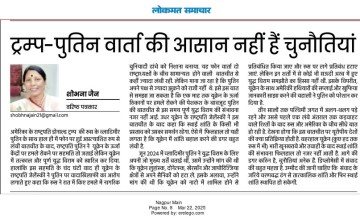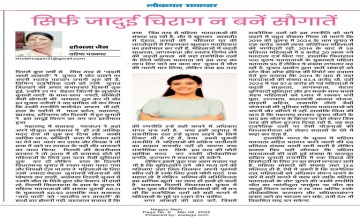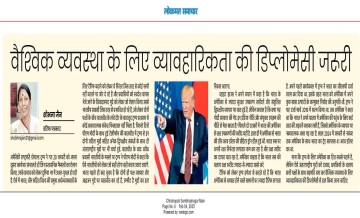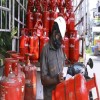Delhi Grapples with Devastating Floods as Yamuna River Swells to Unprecedented Levels

New Delhi, 13 July, (VNI) In a mind-boggling showcase of its awe-inspiring prowess, the mighty Yamuna River has surged to inconceivable magnitudes, unleashing a deluge of unimaginable force upon the hapless water purification infrastructures that presently lie desolate and idle. This apocalyptic phenomenon has ensnared sections of Delhi within the grasp of an imminent dearth of water, a looming catastrophe that demands urgent and undivided focus.
Numerous localities within the metropolis, their residents left in a state of bewildered dismay, find themselves entangled in a labyrinth of inundation and water accumulation. The Yamuna River, ever defiant in its surging glory, persists in its relentless assault on the city, propelled by the ceaseless onslaught of heavy precipitation and the unleashed torrents from the Hathnikund Barrage. The Lieutenant Governor of Delhi, grasping at the straws of control, has hastily summoned the Delhi Disaster Management Authority (DDMA) to confront this unyielding menace.
The water level of Yamuna, a fearsome beast no longer restrained, has soared to an awe-inspiring 208.48 meters at the break of dawn, according to the authoritative Central Water Commission. The Municipal Corporation of Delhi (MCD), trembling beneath the weight of responsibility, reluctantly announces the closure of 10 esteemed educational institutions nestled in the low-lying pockets of the illustrious Civil Lines zone. In the neighboring Shahadra district, 7 educational bastions, their hallowed halls now silent and deserted, stand as stoic witnesses to the calamitous conditions that plague the city.
As the sun sets on another turbulent day, the harrowing saga of Yamuna's rapid ascension reaches unprecedented heights. From a modest 203.14 meters on the previous Sunday morn, the tumultuous river surges forward with unyielding force, scaling the precarious heights to a staggering 205.4 meters by the following Monday afternoon. A veritable race against time, the river, with audacious disregard, breaches the critical threshold of 205.33 meters, a staggering 18 hours ahead of the direly anticipated hour. The Delhi Police, armed with the weaponry of precaution, hastily invokes the formidable Section 144 of the Criminal Procedure Code (CrPC) to safeguard the beleaguered denizens residing in the vulnerable flood-prone areas. The Delhi government, a fragile shield amidst this tempestuous tempest, springs into action, orchestrating the evacuation of 16,564 beleaguered souls inhabiting the treacherous low-lying regions, ushering them towards the uncertain embrace of the provisional havens. Tents and shelters, scattered throughout the city like an intricate tapestry of refuge, currently harbor 14,534 of these evacuees, their fates hanging in the balance. In a desperate plea for assistance, Chief Minister Arvind Kejriwal, his voice tinged with palpable urgency, pens a heartfelt letter beseeching the Central Water Commission to unleash their powers of intervention, lest this burgeoning crisis engulfs the city in an inescapable vortex of despair.
The relentless surge of Yamuna's watery rampage now breaches the borders of low-lying territories, infiltrating the sacred grounds of Kashmiri Gate and ITO. Chief Minister Arvind Kejriwal, his solemn duty demanding his unwavering presence, embarks upon a solemn pilgrimage to the beleaguered Wazirabad Water Treatment Plant. The plant, an industrial sanctuary once brimming with the hum of purification, now stands in desolate abandonment, its once-vibrant operations silenced by the rising tide of Yamuna's wrath.
Alas, the once bustling entrance and exit of the Yamuna Bank Metro Station now lie lifeless and forlorn, entombed in a watery grave. The Delhi Metro Rail Corporation (DMRC), its authoritative voice cutting through the deafening roar of the flood, proclaims the temporary closure of these portals. Yet, a glimmer of hope remains as the interchange facility stubbornly clings to life, its resolute functionality a beacon of solace amidst the chaos. The Blue Line, ever resilient, valiantly carries on, its services undeterred by the swirling waters that now besiege the metropolis.
In an earnest attempt to navigate this treacherous new reality, the Delhi Traffic Police, weary sentinels guarding the city's arteries, issue a harrowing advisory to the unsuspecting commuters. The Yamuna, a relentless invader, infiltrates the city's major thoroughfares, leaving a trail of submerged roads in its turbulent wake. The water level, an ominous sentinel perched at an ominous 208.48 meters, continues to soar above the danger mark. Desperate commuters, bewildered by the unfolding chaos, are left to decipher the treacherous maze of alternative routes, as the listed roads transform into forbidden passages, echoing the cries of frustration and uncertainty.
According to media reports Delhi Minister Atishi conveys a bleak insight into the city's engulfing calamity. With an air of resignation, she acknowledges the water's uncontrollable liberation, transforming tranquil canals into overwhelming torrents. The powerlessness of humanity fuels desperate communication between Delhi and Haryana to quell the relentless flow. Evacuation efforts race against time to relocate trapped souls to relief camps. Reluctantly, the Public Works Department seals the fate of roads, denying access to beleaguered residents. Chaos and heavy traffic congestion loom around Shastri Park.
The Delhi Metro Rail Corporation (DMRC), an indomitable force amidst the swirling tempest, conveys the grim news of the Yamuna's insatiable appetite for disruption. The approach road to Yamuna Bank Metro Station, once bustling with life, now stands as a ghostly reflection of its former self. Commuters, caught in the relentless grip of the raging waters, must now chart a course through uncertain terrain, seeking solace in alternative routes. Yet, amidst the chaos, a glimmer of hope remains as the interchange facility stubbornly clings to its operational existence, a solitary ray of light amidst the shadows of uncertainty.
The rising water level of Yamuna, an indomitable force of nature, unrelenting in its assault on the vulnerable underbelly of Delhi, wreaks havoc upon the city's intricate web of transportation. Traffic movement, once fluid and effortless, now lies in shambles as numerous areas succumb to the relentless deluge. The rising waters, their ferocious advance unyielding, leave behind a trail of submerged streets and disrupted lives.
As the relentless waters surge forward, the iconic Delhi Secretariat, a symbol of administrative prowess, finds itself engulfed in an unholy alliance with the Yamuna. Chief Minister Arvind Kejriwal, a spectator in this unfolding tragedy, witnesses the flooding firsthand. The Public Works Department, an army of dedicated custodians, scrambles to address the situation, coordinating with the beleaguered traffic police and other agencies to salvage what they can from this watery abyss. The road from Rajghat to the Delhi Secretariat, once a bustling thoroughfare, now lies ensnared beneath the water's unyielding grip. The stretch of Ring Road, a vital lifeline connecting Kashmere Gate and Purana Lohe Ka Pul, succumbs to the relentless assault, submerging beneath the swirling depths of the Yamuna. The District Magistrate (East), weighed down by the gravity of the situation, issues a somber proclamation, declaring the closure of Shamshan Ghat in Geeta Colony, its sacred grounds now swallowed by the surging waters.
As the city grapples with the deluge, the education sector bears the weight of the calamity. Chief Minister Arvind Kejriwal, his voice tinged with resignation, decrees that all government and private schools in the afflicted regions of Delhi shall remain shuttered. The pursuit of knowledge, once a beacon of enlightenment, now succumbs to the torrents of uncertainty.
In the midst of the chaos, Chief Minister Arvind Kejriwal embarks on a solemn pilgrimage to the Wazirabad Water Treatment Plant, a testament to the city's determination to confront the ravages of the Yamuna. The once-vibrant heart of purification, now silenced by the rising tide of the river, stands as a stark reminder of the Herculean task that lies ahead.
In this tumultuous narrative of submerged hopes and uncertain futures, Delhi finds itself at the mercy of the mighty Yamuna. As the waters surge and the city quivers, its residents cling to the fragile threads of resilience, bracing themselves for the tempest that rages on.
No comments found. Be a first comment here!









